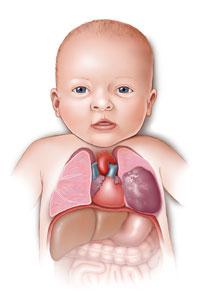Congenital malformations of the respiratory system are disorders of the respiratory system that develop before the baby is born, i.e. during intrauterine life.
The first weeks of pregnancy – from the 4th to the 16th week – are a particularly difficult time for the foetus. Exposure to teratogenic agents such as certain drugs, alcohol, nicotine or X-rays can lead to malformations.
How common are birth defects of the respiratory system?
Respiratory congenital malformations account for up to 4% of all malformations in children. It is the second cause of neonatal death after congenital heart defects.
How do congenital malformations of the respiratory system manifest themselves?
The symptoms depend on the severity of the defect. The most severe congenital respiratory defects can lead to respiratory failure within the first few days of life. Some may remain asymptomatic for a long time and may be discovered accidentally.
Symptoms are closely related to the nature and location of the defect. In order to explain them, some of them are described together with their characteristics.

Lung defects:
- Lung agenesis is a defect where a lung is missing. Agenesis can affect one or both lungs, and is quite often accompanied by congenital malformations of other organs. Bilateral absence of lungs is fatal and the child does not survive birth. In the absence of one lung, the newborn/infant will usually show shortness of breath and cyanosis on exertion, such as eating. Any infection is dramatically severe and often leads to respiratory failure. Due to the compensatory hypertrophy of the only lung, there are sparse cases with only frequent respiratory infections. The diagnosis is established on the basis of a review chest X-ray and, if necessary, bronchoscopic examination.
- lung aplasia – in contrast to lung agenesis, in the case of this malformation a vestigial main bronchus is formed, but there is no active lung parenchyma, i.e. the part of the lung responsible for gas exchange. The symptoms are analogous to those of aplasia. The conclusive test for diagnosis is bronchoscopy.
- lung hypoplasia – the main bronchus and further division of the bronchial tree into lobed bronchi are present, but these structures are abnormally formed and the surrounding lung parenchyma is immature, which leads to disorders in its proper functioning. Very often this malformation is accompanied by vascularisation abnormalities of the affected lung. In as many as 50% of cases, defects in another organ are present. The cause of pulmonary hypoplasia is thought to be compression of the developing lung in the womb and preventing it from growing properly. This happens for example in microcephaly, diaphragmatic hernia or deformity of the chest. The symptoms of a defect can be detected immediately after birth, or they can manifest themselves at a later stage. It is not uncommon for defects of another organ to be discovered first. In addition to a chest X-ray, bronchoscopy is the examination that confirms the diagnosis. In justified cases, a chest CT scan is performed.
Bronchopulmonary defects:
A bronchopulmonary cyst is a defect involving the presence of a cyst in the structure of the bronchial tree. A cyst is an oval or round structure, usually filled with fluid. It can be single or multiple. A cyst that has no outlet to the bronchus will enlarge over time. Depending on its size and location, the child will develop different symptoms. Large cysts compressing the bronchus and impairing its patency cause shortness of breath.
Small cysts may cause few symptoms, but they can also cause frequent respiratory infections. In any case, the contents of the cyst may become infected with bacteria and give symptoms of a severe infection with fever, cough and even expectoration of blood. Cysts are detected with a review chest X-ray and a chest CT scan. Successful treatment involves surgical removal of the cyst.
Congenital pulmonary adenomyomatosis – a large number of cysts develop within the lung parenchyma in a limited area (i.e. not the whole lung). The pathology usually affects one lung. The defect is often already diagnosed during pregnancy, before the baby is born. Symptoms in most cases occur early after birth. Features of respiratory failure, dyspnoea and cyanosis appear.
In some children with pulmonary adenomycosis with a small number of cysts, symptoms in the form of recurrent respiratory infections occur later. Pneumothorax and coughing up blood may be observed in some patients. If the diagnosis is not established prenatally, the defect is diagnosed at birth on the basis of a chest X-ray or, in doubtful cases, on computed tomography. The treatment is surgical removal of the affected part of the lung.

